The Gentle Giants: A Guide to Large Rabbit Breeds for 2025
Are you looking for a furry friend that's larger than life? Well, look no further because, we're going to introduce you to the gentle giants of the rabbit world.
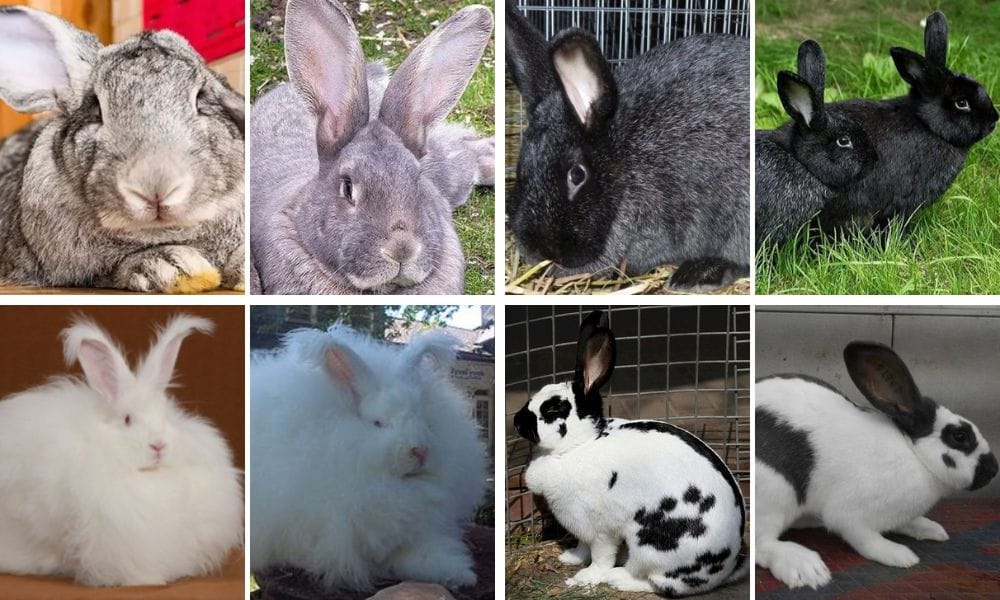
Introduction to Large Rabbit Breeds
Large rabbit breeds, such as the Flemish Giant rabbit, have been a popular choice for many rabbit enthusiasts and breeders. The nearly extinct Spanish Giant, known for its unique traits and history of decline, has seen revitalization efforts in Spain since 2009. These giant rabbit breeds are known for their massive size, gentle nature, and beautiful coats. The Champagne D'argent, one of the oldest rabbit breeds, traces its origins back to 1600s France. With proper care and attention, large rabbit breeds can make wonderful companions for families and individuals alike. In this guide, we will explore the characteristics, history, and lifespan of large rabbit breeds, including the Flemish Giant, Giant Chinchilla, and other popular breeds. These rabbits are not only impressive in size but also in their affectionate and docile demeanor, making them a delightful addition to any home.
Characteristics of Large Rabbit Breeds
Large rabbit breeds are characterized by their massive size, with some breeds weighing up to 22 pounds or more. The Flemish Giant, for example, is the largest breed of domestic rabbit, with an average weight of 15 pounds. Similar to other large rabbits, the lifespans of checkered giant rabbits range from approximately 5 to 8 years. These rabbits have a semi-arch body shape and a broad head with erect ears. Other characteristics of large rabbit breeds include their gentle and docile nature, making them a great choice for families with children. The Giant Chinchilla, for instance, is known for its calm and gentle temperament, while the Silver Fox breed is prized for its silky soft coat. Large rabbit breeds also require a lot of space to move around, and their diets need to be carefully managed to ensure they stay healthy and happy. Providing a balanced diet rich in high-fiber hay, fresh vegetables, and a limited amount of pellets is essential for maintaining their health. Large domestic rabbits, while charming and offering great companionship, have specific care requirements and health concerns that potential owners should be aware of.
History of Large Rabbit Breeds
The history of large rabbit breeds dates back to the 16th century, when breeders began selectively breeding rabbits for their size, fur, and meat. Unlike domesticated rabbits, wild rabbits cope with heat by burrowing underground, a natural ability that helps them escape high temperatures. The Flemish Giant, for example, was originally bred in Flanders, Belgium, for its fur and meat purposes. Over time, however, these breeds have become popular pets, prized for their gentle nature and beautiful coats. The Giant Angora, for instance, was originally bred for its soft and fluffy fur, while the Continental Giant was bred for its massive size. Today, large rabbit breeds are kept as pets, shown in rabbit shows, and bred for their unique characteristics. The selective breeding processes created these colossal rabbits, making them a fascinating part of rabbit history and a beloved choice for rabbit enthusiasts.
Popular Large Rabbit Breeds
Large rabbit breeds have become increasingly popular as pets due to their gentle and sociable nature. Among the most beloved are the Flemish Giant, Continental Giant, and Giant Chinchilla. The Flemish Giant, in particular, stands out with its massive size and docile temperament, making it a favorite among rabbit enthusiasts. These gentle giants are known for their affectionate nature and impressive stature, often weighing over 20 pounds.
Other popular large rabbit breeds include the Checkered Giant, known for its distinctive spotted pattern, and the Giant Angora, prized for its luxurious wool. The Silver Fox, with its shimmering silver-tipped fur, is another favorite, admired for its calm and friendly demeanor. These breeds, often referred to as “giant breeds” or “large pet rabbit breeds,” are cherished for their unique characteristics and traits, making them delightful companions for families and individuals alike.
Key Takeaways:
- Discover the fascinating world of large rabbit breeds, their unique characteristics, and care requirements.
- Learn about the history and origins of some of the largest rabbit breeds recognized by the American Rabbit Breeders Association.
- Understand why these gentle giants, such as the Flemish Giant and French Lop, make excellent family pets and companions.
Rabbits are not just the small, cuddly pets that many people imagine. There is a whole other side to these creatures – the world of large rabbit breeds. These massive rabbits, often referred to as 'gentle giants', can be as big as a medium-sized dog and are known for their docile and affectionate nature. In this comprehensive guide, we will hop into the world of large rabbit breeds, exploring their history, characteristics, and why they might just be the perfect addition to your family.
Flemish Giants: The Kings of the Rabbit World
The Flemish Giant is one of the oldest and most well-known large rabbit breeds. Originating from Belgium, these rabbits are known for their impressive size, with some individuals weighing over 20 pounds. The Flemish Giant rabbit lifespan typically ranges from 8 to 10 years, and a proper diet and health care can potentially extend their life. They have a semi-arch body shape, a broad head with erect ears, and a dense coat that comes in a variety of colors, including black, blue, and light gray. Flemish Giants are not only the largest rabbit breed but also one of the most gentle and friendly, making them great house pets.
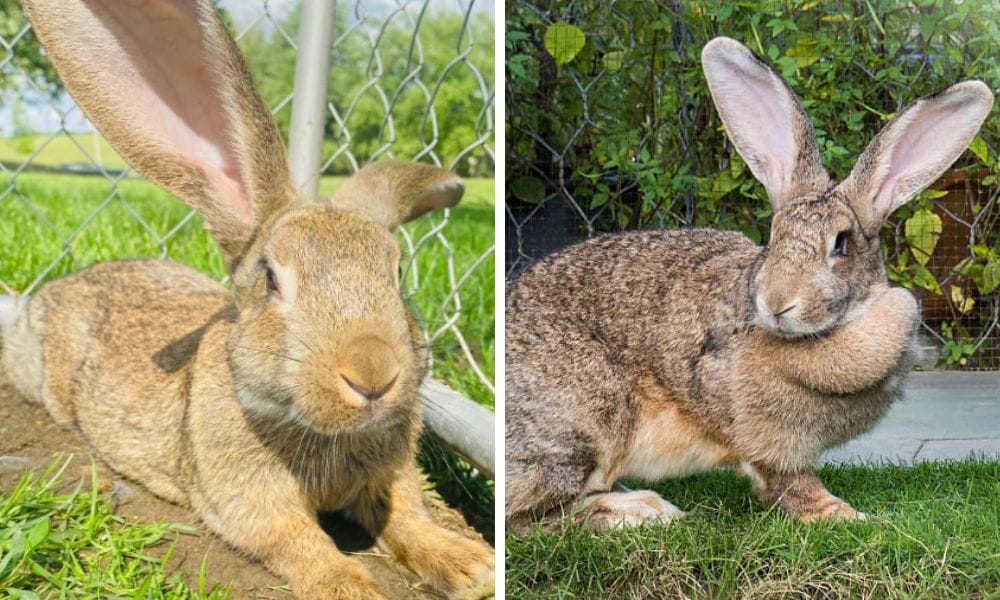
French Lop: The Ear-resistible Giant
Another popular large breed is the French Lop. This breed was created by crossing the English Lop with the Flemish Giant, resulting in a rabbit with the distinctive lop ears and a sizeable build. French Lops can weigh over 15 pounds and have a dense, soft coat. They are known for their laid-back and affectionate nature, which makes them an excellent family pet, especially for first-time rabbit owners.
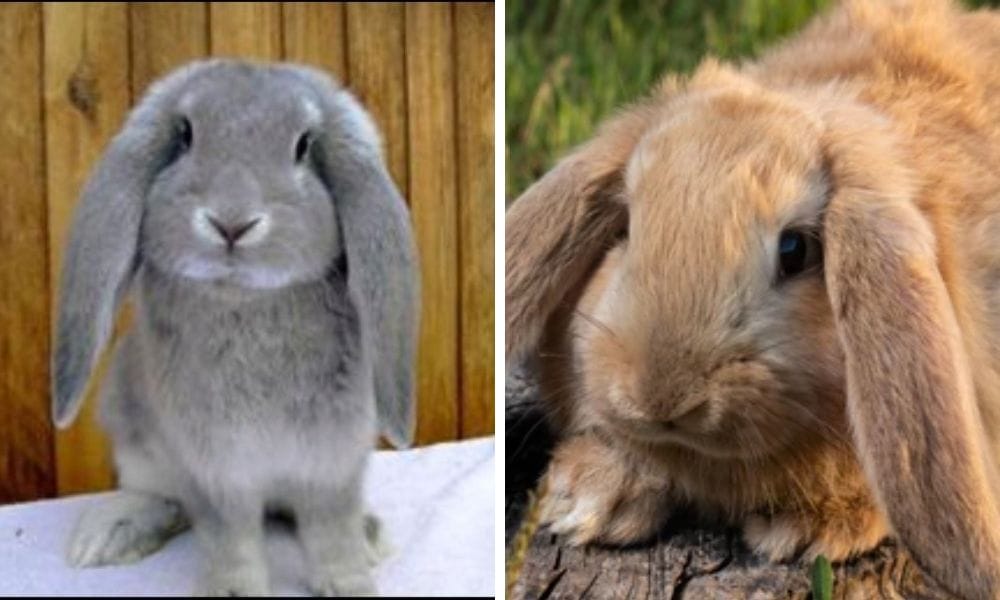
Giant Chinchilla: The Rare Gentle Giant
The Giant Chinchilla is a very rare breed that was originally bred in the United States. It shares the soft, dense fur of the smaller Chinchilla rabbits but on a much larger scale. These rabbits can weigh up to 16 pounds and have a beautiful, dense coat that is predominantly a light gray color. Despite their size, Giant Chinchillas are known for their calm and friendly demeanor. The Flemish Giant breed likely resulted from breeding the now extinct Patagonian rabbit with smaller, more docile rabbit breeds. Giant Chinchilla Rabbit Lifespan is typically 8-9 years.
Giant Angora: The Woolly Wonder
For those who love the fluffy look, the Giant Angora is a breed that stands out. Recognized by the American Rabbit Breeders Association, the Giant Angora is the largest of the Angora rabbit breeds, with a weight that can exceed 10 pounds. They are covered with soft, angora wool, which requires regular grooming. Giant Angoras are not just beautiful; they are also friendly and can make wonderful pets with the right care.

Silver Fox: The Shimmering Giant
The Silver Fox is a large rabbit breed with a unique, dense coat that stands out for its silver-tipped fur. This breed was created in the United States and is one of the few rabbit breeds to be developed here. The Silver Fox's calm temperament significantly contributes to its popularity as a pet rabbit in the United States, making it suitable for both children and adults. Silver Fox rabbits are known for their calm and affectionate nature, and they can weigh up to 12 pounds. They are a great choice for those looking for a large breed with a striking appearance.
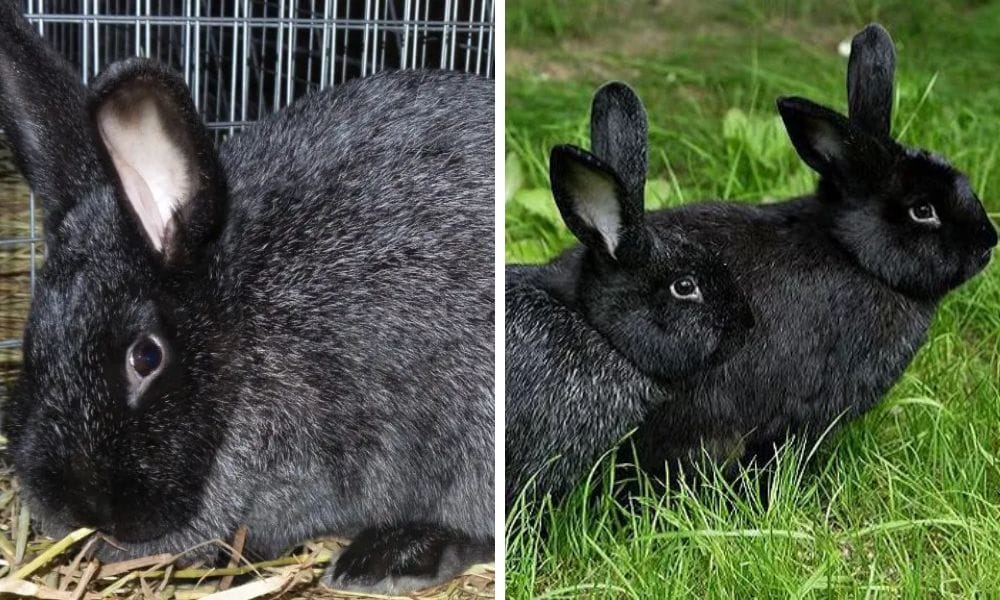
Checkered Giant Rabbit: The Spotted Sensation
The Checkered Giant is a distinctive breed with a spotted pattern that is instantly recognizable. The checkered giant rabbit lifespan ranges from approximately 5 to 8 years, similar to other large rabbit breeds. They are one of the largest breeds, with a minimum weight of 11 pounds for does and 12 pounds for bucks, and no maximum weight. These rabbits have a long, lean body, broad ears, and a pattern of black or blue markings against a white background. They are an active breed and require plenty of space to move around.
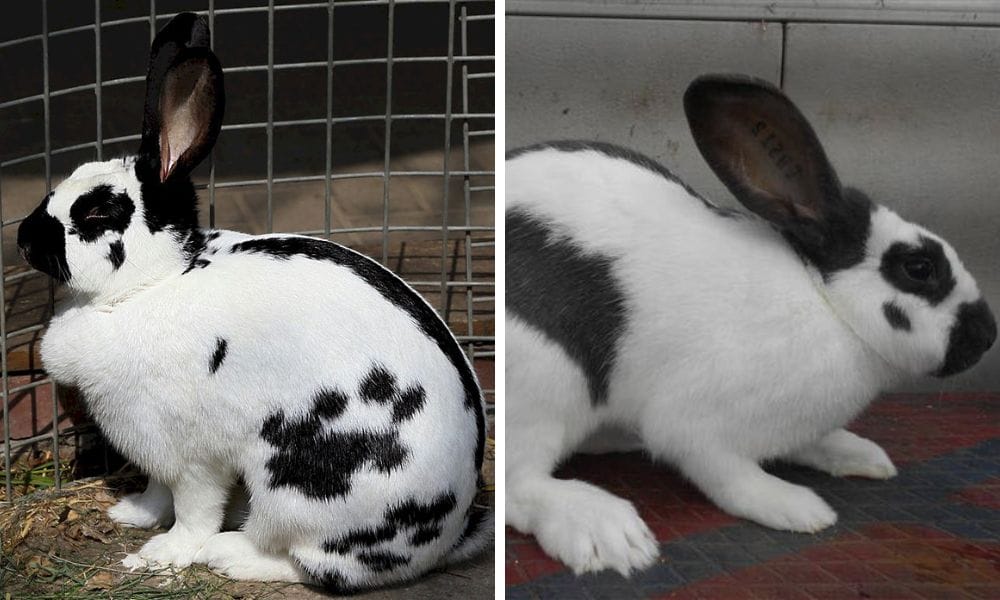
Continental Giant: The European Behemoth
The Continental Giant, also known as the German Giant, is another massive rabbit breed that originated in Europe. They are one of the world’s largest rabbit breeds, with some individuals weighing over 20 pounds. The continental giant rabbit lifespan ranges from 5 to 12 years. Continental Giants have a powerful build, with long, strong hind legs and broad ears. They are a docile breed and are known for being gentle and easy to handle.

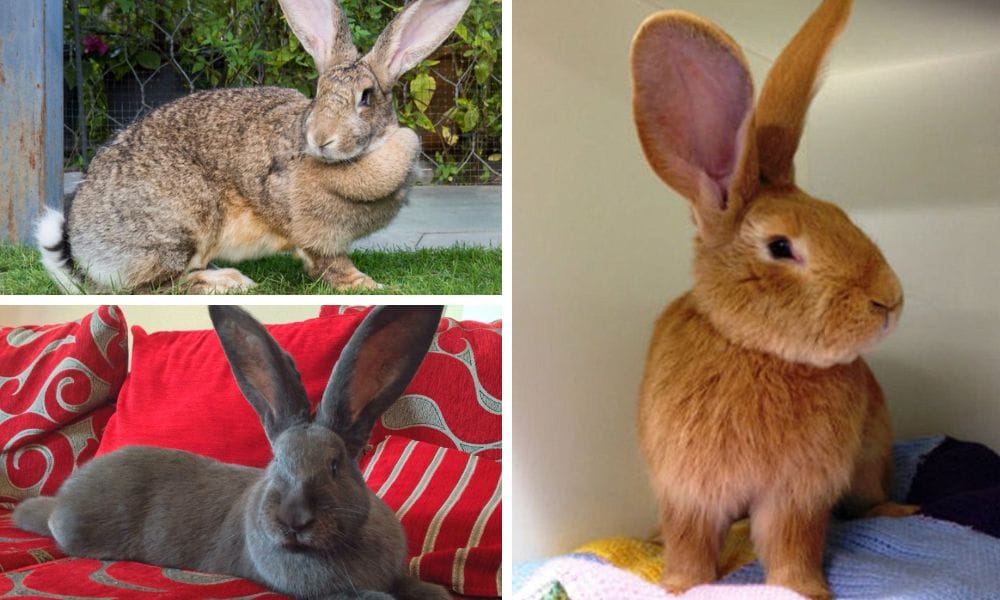
British Giant: The UK's Proud Giant
Across the pond, the British Giant is a large breed recognized by the British Rabbit Council. These rabbits are slightly smaller than their Continental cousins but still boast an impressive size. They have a semi-arch body shape and can come in a variety of colors, including black, blue, and opal. British Giants are known for their friendly nature and make great companions.
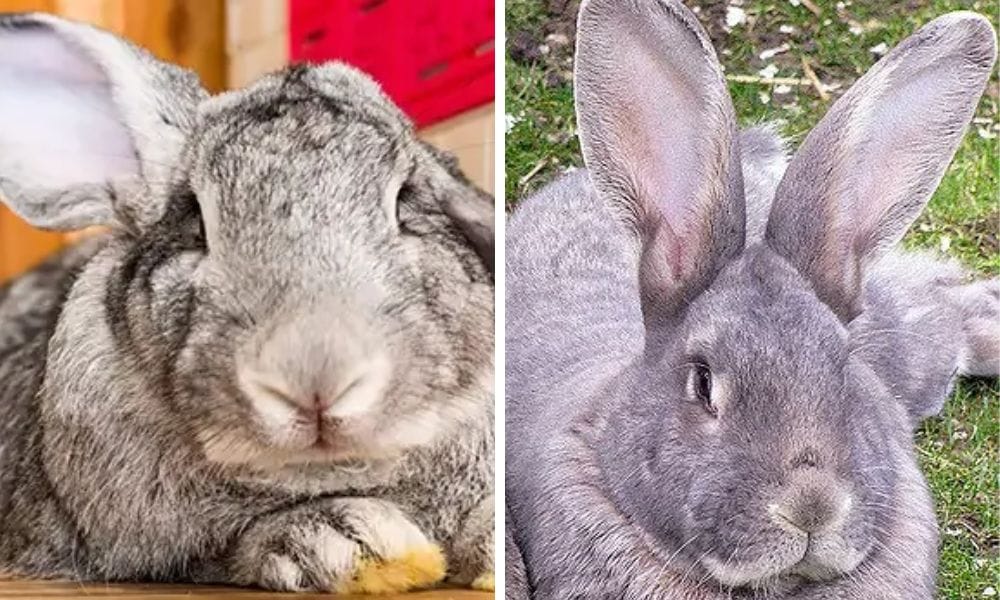
Diet and Nutrition for Giant Rabbit Breeds
Giant rabbit breeds, such as Flemish Giants and Continental Giants, require large rabbit breed diets that support their large size and promote good health. Larger rabbits require significantly more food to keep their large bunny's belly full. These diets are similar to those of smaller breeds but require significantly more food, including a substantial amount of high-fiber hay, which should constitute the bulk of their diet. The hay helps maintain their digestive health and prevents obesity, which can be a concern for larger breeds. Fresh vegetables and a limited amount of pellets also play a crucial role in their nutrition. Owners should be mindful of the calcium content in the veggies, as too much can lead to urinary issues in these big bunnies.

In addition to hay, fresh water is essential for giant rabbit breeds. They consume more water than other rabbit breeds due to their size. Owners should ensure that their water bowls or bottles are always filled with clean water. Treats should be given sparingly, as excessive treats can lead to weight gain. When introducing new foods to their diet, it’s important to do so gradually to avoid upsetting their sensitive digestive systems. A balanced diet from a young age is key to maintaining the health and happiness of these majestic creatures.

The American Checkered Giant: A Showstopper Breed
The American Checkered Giant, not to be confused with its European counterpart, is a breed that captures attention with its distinctive spotted coat. Created by crossing large spotted rabbits with Flemish Giants, the Checkered Giant boasts recognizable butterfly-shaped markings on their face. Known for their black and blue markings against a pristine white background, these spotted rabbits are a favorite among rabbit show enthusiasts. The Checkered Giant is one of the oldest breeds in the United States, having been recognized by the American Rabbit Breeders Association (ARBA) for over a century. Their striking appearance and friendly demeanor make them a popular choice for those looking to add a bit of flair to their rabbitry.
Despite their size, which can rival that of a medium-sized dog, the American Checkered Giant is known for its graceful movements and playful nature. They are an active breed that requires ample space to hop and explore. First-time rabbit owners should be prepared for the commitment of caring for one of the world’s largest rabbit breeds. These gentle giants need a diet rich in fiber, plenty of exercise, and regular interaction with their human companions to thrive. Their unique pattern and colored ears make them stand out in any crowd, ensuring they’re always the center of attention.
Housing and Space Requirements for Flemish Giant Rabbits
Flemish Giant rabbits, often referred to as the world's largest rabbit breed, require ample space to thrive. Unlike their smaller counterparts, these gentle giants need an enclosure that is at least four times their size when fully stretched out. This means that a single Flemish Giant's habitat should be comparable to that of a medium-sized dog kennel. It's crucial to provide a living area that allows them to move freely, stand on their hind legs without hunching, and have separate zones for sleeping, eating, and litter training.
Creating an appropriate living space for a Flemish Giant rabbit is not just about size; it's also about safety and comfort. The flooring should be solid to prevent sore hocks, a common issue among large breeds, and the enclosure should be secure from predators if kept outdoors. Additionally, these rabbits benefit from having access to a larger, rabbit-proofed area where they can exercise and explore for several hours each day. This not only promotes physical health but also mental well-being, reducing the risk of boredom and destructive behaviors.
The Ideal Owner for a Giant Rabbit Breed
First-time rabbit owners might be enchanted by the idea of owning the world's largest rabbit, but Flemish Giants and other large breeds require a dedicated caretaker. Prospective owners should be prepared for more than just the novelty of their size; they must understand the commitment involved in caring for a pet that can live up to 10 years or more. These rabbits need consistent, gentle handling to maintain their social nature and to prevent them from becoming skittish or aggressive.
The ideal owner for a Flemish Giant rabbit is someone who has the time, space, and resources to provide for their unique needs. They should be ready to invest in a large enough habitat, provide a diet rich in hay, fresh vegetables, and a proper balance of nutrients, and commit to regular veterinary care, which can be more costly due to their size. Additionally, they should have the patience and passion for engaging in daily socialization and enrichment activities. With the right owner, these black, blue, and various other colored giants can become a beloved and rewarding member of the family.
The Vienna Rabbit: A Touch of Color in the Giant World
The Vienna rabbit is a lesser-known giant rabbit breed that boasts an intriguing history and a variety of colorations. While not as large as the Flemish Giant, the Vienna rabbit is still considered a large breed of rabbit, with a calm and friendly temperament that makes it suitable for families. Originating from Europe, the Vienna rabbit has contributed to the development of several other breeds, including the beloved chinchilla rabbit, known for its soft, dense coat that resembles the fur of a chinchilla.
Vienna rabbits are appreciated for their gentle nature and the variety of colors they come in, including the sought-after blue hue. They are a versatile breed, suitable both as a pet for rabbit enthusiasts and as a show animal due to their beautiful appearance and good-natured personalities. Their size and weight place them between the smaller breeds and the largest breed of rabbits, making them an excellent choice for those who want a substantial pet without the extreme size of the Flemish Giant. With proper care and attention, the Vienna rabbit can be a delightful addition to any household, bringing a touch of color and charm to the world of giant rabbit breeds.
Socialization and Behavior of Giant Rabbit Breeds
Giant rabbit breeds, including the Flemish Giant rabbits and the Continental rabbit, are known for their docile and friendly nature, making them excellent companions. However, socialization is crucial from a young age to ensure they grow up to be well-adjusted pets. Introducing them to various people, other pets, and new environments can help prevent fearfulness and aggression. These interactions teach them to be comfortable around others and can enhance their natural sociability. It's also important for first-time rabbit owners to understand that despite their calm demeanor, giant breeds may require more space and exercise than other breeds.
Understanding the behavior of giant rabbit breeds is essential for creating a harmonious living environment. For instance, the biggest rabbit breed may exhibit a strong need for mental stimulation and physical activity. Providing them with toys and opportunities for exploration can help satisfy these needs. Owners should also be aware that rabbits, regardless of size, are prey animals and can be skittish. Gentle handling and a quiet, safe space are important for their well-being. Observing their behavior and body language can give insights into their needs and help strengthen the bond between pet and owner.
Spanish Giant: The Iberian Impressive
The Spanish Giant is a lesser-known large rabbit breed that originated in Spain. The Spanish Giant rabbit lifespan typically ranges from 7 to 10 years. They are known for their large size and strong build, with a weight that can exceed 15 pounds. Spanish Giants have a calm temperament and are suitable for families looking for a large, affectionate pet.
The Spanish Giant was developed through crossbreeding with other large Spanish breeds.
Hungarian Giant: The Central European Charm
The Hungarian Giant is a large breed that is not as widely known as some of the other giant breeds. The Hungarian giant rabbit lifespan typically ranges from 8 to 12 years. The Hungarian Giant’s weight range is between 9 to 12 pounds, making it one of the smaller giants. They have a robust build and can weigh up to 15 pounds. Hungarian Giants are known for their friendly nature and can be a good choice for those looking for a large rabbit breed that is not as common.
Palomino Rabbits: The Golden Giants
Palomino rabbits are a large breed that is known for their beautiful golden color. They have a sturdy build and can weigh up to 11 pounds. Palominos are a docile breed and are known for their friendly and calm demeanor, making them suitable for families and rabbit enthusiasts alike.
Blanc de Bouscat Rabbit: The French Elegance
The Blanc de Bouscat is a large rabbit breed that originated in France. Known as a docile family pet, it is celebrated for its intelligence and gentle nature, making it suitable for households with children and other pets. They are known for their pure white coat and pink eyes, which give them an elegant appearance. Blanc de Bouscat rabbits can weigh up to 12 pounds and are known for their calm and friendly nature.
Giant Papillon: The Patterned Giant
The Giant Papillon, also known as the Checkered Giant in the United States, is a large breed that is known for its distinctive spotted pattern. The Giant Chinchilla rabbit, created through the breeding of a Flemish Giant and the Chinchilla breed, is another large breed worth mentioning. They have a strong, muscular build and can weigh over 15 pounds. Giant Papillons are an active breed and require plenty of space to thrive.
New Zealand Rabbits: The Versatile Giants
New Zealand rabbits are a large breed that is known for their versatility. They were originally bred for meat and fur, but they also make great pets. New Zealand rabbits have a solid build and can weigh up to 12 pounds. They come in a variety of colors, including white, red, and black, and are known for their friendly and docile nature.
Mini Lop and Mini Rex: The Smaller Cousins
While not considered large breeds, the Mini Lop and Mini Rex are worth mentioning as they are often confused with their larger counterparts. Mini Lops have a compact size and distinct lop ears, while Mini Rex rabbits are known for their velvety fur. Both breeds are smaller than the large breeds discussed but share the friendly and docile traits that make rabbits wonderful pets.
Caring for Your Gentle Giant
Caring for large rabbit breeds requires some special considerations. Using an extra large dog crate can be a creative solution for providing ample space for giant rabbits. Due to their size, these rabbits need more space than smaller breeds. A large, secure enclosure is essential, as is regular exercise. Their diet should be carefully managed to prevent obesity, and they may require more grooming, especially for breeds with long or dense fur. These giant rabbit breeds, often referred to as plus sized bunny companions, are known for their sociability and gentleness, making them excellent pets for families with children and other pets.
Health Considerations for Large Breeds
Large rabbit breeds can be prone to certain health issues, such as sore hocks and spinal problems, due to their weight. It’s important to provide a soft resting area and monitor their health closely. Regular veterinary check-ups are crucial to ensure your giant rabbit stays healthy and happy.
Maintaining a giant bun healthy entails providing plenty of fresh greens, unlimited hay, and a high-quality pelleted diet, along with the need for ample exercise to ensure a long and happy life.
Lifespan of Large Rabbit Breeds
The lifespan of large rabbit breeds varies depending on the breed, genetics, and diet. The American rabbit lifespan ranges from 5 to 10 years. On average, large rabbit breeds can live for 5-12 years, with some breeds living up to 15 years or more. The giant angora rabbit lifespan ranges from 5 to 12 years. The Flemish Giant, for example, has an average lifespan of 8-10 years, while the Giant Chinchilla can live for 7-10 years. The British Giant rabbit lifespan is around 5-8 years, while the Hungarian Giant rabbit can live for 8-12 years. With proper care and attention, large rabbit breeds can live long and happy lives, making them a great choice for families and individuals who are willing to make a long-term commitment to their pet. Regular veterinary check-ups, a healthy diet, and plenty of exercise can help ensure that large rabbit breeds live a long and healthy life. Providing a spacious and safe environment, along with mental stimulation and social interaction, is key to their well-being and longevity.
Accommodating Large Rabbit Breeds
Accommodating large rabbit breeds requires careful consideration of their space and exercise needs. Unlike smaller rabbit breeds, these gentle giants need plenty of room to move around and exercise. A typical cage for a large rabbit breed should be at least 2x4x4 feet in size, providing ample space for the rabbit to stand up, turn around, and lie down comfortably. It’s essential to ensure that the enclosure is secure and spacious enough to prevent any stress or discomfort.
In addition to a roomy cage, large rabbit breeds require regular exercise outside of their enclosures. This can include playtime in a secure, rabbit-proofed room or a large, enclosed outdoor area. Providing plenty of hiding places, toys, and enrichment activities is crucial to keep them stimulated and engaged. These activities not only promote physical health but also mental well-being, ensuring that your large rabbit remains happy and healthy.
Handling Large Rabbit Breeds
Handling large rabbit breeds requires care and caution due to their size and strength. It’s essential to support the rabbit’s body and lift them carefully to avoid injuring their back or legs. When lifting a large rabbit, one person should support the rabbit’s body while another person lifts them, ensuring that the rabbit feels secure and comfortable.
Regular handling is important to help large rabbit breeds become accustomed to human interaction. However, it’s crucial to remember that these rabbits may not always enjoy being handled and may prefer to be left alone. Handling should be kept to a minimum, and rabbits should be given plenty of space and time to rest and relax. Gentle and consistent handling can help prevent fearfulness and aggression, making your large rabbit a well-adjusted and friendly companion.
Breeding and Showing Large Rabbit Breeds
Breeding and showing large rabbit breeds require a deep understanding of the breed’s characteristics, temperament, and genetics. Breeders must carefully select breeding stock to ensure that the offspring will have the desired traits and characteristics. This involves a thorough knowledge of the breed standard and the ability to identify the best features in potential breeding pairs.
Showing large rabbit breeds is a rewarding experience that requires dedication and attention to detail. Rabbits are judged on their conformation, temperament, and overall appearance, making it essential to present them in the best possible light. Popular large rabbit breeds for showing include the Flemish Giant, Continental Giant, and Giant Chinchilla. These breeds are often showcased at rabbit shows and competitions, where their impressive size and unique characteristics are celebrated.
By understanding the intricacies of breeding and showing, enthusiasts can contribute to the preservation and improvement of these magnificent breeds, ensuring that they continue to thrive and captivate audiences for generations to come.
Summary
Large rabbit breeds offer a unique experience for pet owners. These gentle giants are known for their friendly and docile nature, making them excellent family pets. Breeds like the Flemish Giant, French Lop, and Giant Chinchilla are just a few examples of the large breeds that can bring joy and companionship to your home. When considering a large rabbit breed, it's important to understand their specific care requirements, including space, diet, grooming, and health monitoring. With the right care, these large rabbits can become a beloved part of your family for years to come.
FAQ Section
Q: What is the largest rabbit breed? A: The Flemish Giant is considered the largest rabbit breed, with some individuals weighing over 20 pounds.
Q: Are large rabbit breeds good for first-time owners? A: Yes, many large rabbit breeds, such as the French Lop and the British Giant, are known for their gentle and friendly nature, making them suitable for first-time rabbit owners.
Q: How much space do large rabbit breeds need? A: Large rabbit breeds require more space than smaller breeds due to their size. They need a large, secure enclosure for their habitat and plenty of room to exercise and explore safely.
Q: What is the world's largest rabbit? A: The world's largest rabbit is a Continental Giant named Darius, who measures 4 feet, 3 inches and weighs almost 50 pounds.

